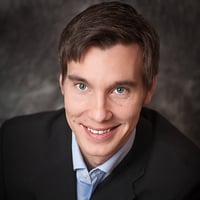The Data Handbook
How to use data to improve your customer journey and get better business outcomes in digital sales. Interviews, use cases, and deep-dives.
Get the book
Succeeding in digital business requires a number of key strategic initiatives with a forward-thinking approach. As IT Director of Kämp Collection Hotels in Finland, Juhani Rajala explains his methodology and how he took the reins of the hotel chain’s IT department. His leadership has led to an exceptionally well-oiled sales-enabling IT organisation that has become an inspirational, sales-driven IT powerhouse.
 Interviewee:
Interviewee:
Kämp Collection Hotels | Juhani Rajala, IT Director
What does digital sales mean for your business?
Juhani: The hospitality business as it runs today is quite digitised already. Think back to the last time you walked into a hotel to tell the reception you need a room. That hasn’t been common for a while now. It’s obvious that most people are already booking through a digital channel, either through the hotel’s website or through an online travel agency (OTA).
If we look at the history, the leaders of this trend by far have been the OTAs, like booking.com and hotels.com. Those completely took over the digital business of the hotel industry, later followed by the hotels building their own channels, web presence and their own ways of handling their digital sales.
An estimated 80-90% of our hotel business comes through online in some way.
What kind of tactics are you using to differentiate yourselves from other hotels and from OTAs?
Juhani: Looking at our Kämp Collection Hotels, we operate 10 hotels in the Helsinki metropolitan area. Our hotels are fighting for the same customers in addition to the external competition. We’ve succeeded in learning about our customers. It's about putting the customer in the centre. It’s that simple, although not a simple process to get there. We try to understand the different types of customers and their range of needs. From there, we leverage the digital tools to implement that knowledge into our customer journeys online and on social media.
What OTAs do is use the same keywords and put a lot of money behind the marketing, which is why they are everywhere. They are also trying to win the customers’ loyalty by offering tangible value like free hotel stays.
How has Kämp Collection Hotels been so successful in its online presence and made an impact?
Juhani: Back in 2016, we needed to change our strategy to dive fully into the digital world. When making that move, we didn’t start by just simply building a website or by sending newsletters. We began building up our technology so that it could support our digital growth. This created the baseline for the web structure, websites and web funnels. But at its best, technology is only an enabler.
During the same time, we really started to build our brands. It is about building a great brand and then enforcing it through marketing. We created brand guidelines where all the brands were redefined. This brand renewal took into account all the normal digital factors like colours, fonts and imagery, but also all the fine details like the scents in the lobbies and the music that gets played. Obviously, marketing was the driver of this but our IT and revenue experts were involved and working hand-in-hand with them every step of the way.
We built from the very bottom, started to add on and we’ve been successful in the initial fast ramp-up of our hotel sites and services — 50 services between 2016-2020 — almost one release per month for every month for the last five years. After the launch, we brought in and tested new services and started to optimise. It’s only after the very detailed pre-work that you can start optimising the booking flows and the services that you offer.
Today, with the optimisations and by chipping away all the friction in the purchasing process, we’ve been able to ramp up growth in digital sales by more than 500% in the last 5 years.
500%? Amazing! How was that achieved?
Juhani: We individually analysed each of our websites, looking at everything from where they were hosted, what technology they were running on and the performance of each. From the information collected, we built a road map, considering our customers and where our website traffic was coming from. We looked not only at current customers, but also the areas of the world we anticipated guests coming from in the future (again based on the brand work and strategy).
Based on customer demographics, the volumes, our technology stack and the road map, we then selected a single CMS platform for all our hotel properties that would support our forward growth.
Knowing where our customer traffic was coming from, we selected Amazon’s cloud hosting platform to be able to provide timely global access and so we can use their CDN to distribute our images and the data. This meant that the response times for the website and services in Beijing would be the same as next door in Helsinki.
Next, we considered the customer journey for our online customers, based on what we knew and have learned about our customers. We changed the concept so that instead of it being a website, it would be a webshop. We made a webshop that resembled a nice hotel website with all the information that gave new and returning customers a feeling of “Hey, I want to stay there.” From there, it was making the purchase journey very simple: just one or two clicks. Of course, we are still missing many elements that I would like to implement, so it’s not ready yet. These things are more like processes, evolving all the time via agile sprints or projects.
This is a true example of looking at the entire customer journey in the big picture. It’s basically the ultimate customer journey. Well done.
Juhani: Thank you. Yes, a customer considers the image quality and professional feel of the website, and the customer considers the services. Those create the digital identity of the hotel and should go hand-in-hand and be aligned with the hotel’s physical operation, service attitude, the smiles, the physical cleanliness, physical surroundings, music, and all the senses that you can feel when you're locally there. We have worked very hard to align the online customer experience and the physical customer experience.
We see several different phases in the customer journey that goes something like this:

Google calls the most important moment on the customer journey Zero Moment of Truth (ZMOT), and I think their eBook called “Winning the Zero Moment of Truth” is a must-read for everyone selling online. Experience doesn't just happen. If you want experiences to happen, those need to be designed. That means going fully through the customer journey and designing the experience of what will happen in each phase. In my opinion, in many industries this is a vital aspect that is often overlooked.
How did you manage to execute it all in a way that the customer vision was materialised on the sites at the same time and developers were doing the right things, from a coordination aspect?
Juhani: We had a small team and a flat team structure but, of course, there are challenges between different business units. That’s natural, because they mostly focus on their own hotels, operations and demand certain things.
From a customer journey perspective, there are many common aspects and many non-common aspects with the business units. For example, many of our customers like to stay in more than one of our hotels and are comparing them and picking their favourites. There might be nothing wrong with the other hotels, different people just prioritise different things more than others. It’s difficult to understand without putting the customer hat on.
It’s about working on it together to get the discussion going between the business units and understanding other points of view. It’s about finding that common understanding so that everybody knows the main priority for the hotel and for the whole group. What is the common cause that will drive us forward together?
Sometimes it takes time to understand what that number one priority actually is.
Did you define any metrics for what you want to achieve with the digital channels at different touchpoints?
Juhani: We defined some metrics — including some already before we started. Some of those included looking at the volumes and striving to increase the amount of traffic with certain numbers. We also wanted to increase the number of conversions by a certain number and increase the number of euros we see by channel. We also tested different approaches, such as the order in which to offer the rooms to get the most sales. Total sales is what matters, not just selling expensive rooms. We can always later offer upgrades to the experience.
We put those figures in place so we would have a target to drive for. We also implemented a dashboard so that it is easy to follow the KPIs. An example would be a newsletter or social campaign so that we targeted to have a reach of X. Then we targeted the link opening rate and then the purchase rate and the promotion rate.
That was also a learning journey for us. We were figuring out the entire process of how this whole thing works and the right metrics to follow. We changed some of the metrics along the way because what we were measuring was not guiding us in the right direction. What was perhaps more important than the exact metrics is that we learned how to drive those metrics. We learned what the actual trigger points are that change those metrics.
How were you testing and were your IT developers involved in experiments and implementations?
Juhani: Yes, we needed to test different things to learn which types of solutions or campaigns worked best. A marketing campaign on Facebook may drive loyalty or brand value but might not convert euros in the short term. On the other hand, we may have another type of campaign with the target to actually convert euros and be less about brand value. You have to choose your focus.
We involved technical partners in these discussions quite early on, so we received the feedback from a deeper IT perspective as well. Everyone who’s worked with technology knows that the tech people are always brought on too late. We wanted to avoid that.
One of the biggest lessons was that we don't live in a perfect world. We are running some legacy systems, which is just a fact of life. This did prevent some changes we wanted to make. As IT experts and as sales and marketing professionals, we simply needed to face the fact that sometimes we just have to go with the tools that we have. Then people start to learn how to make the best of what they have. Don’t stand behind excuses, look for alternatives.
“Whoever guides your technical people needs to have business skills. They must understand the bigger role and target of the business.”
– Juhani Rajala, IT Director at Kämp Collection Hotels
It sounds like your IT developers were quite motivated and in constant communication with the business — really on top of it. Not at all the traditional IT of receiving tickets and requests.
Juhani: It starts from the management. From the CEO. From the CIO. It needs to be an ongoing discussion and collaboration through all teams. I still emphasise that whoever guides your technical people needs to have business skills. They must understand the bigger role and target of the business. If IT leaders are just working under the hood and fixing the engine, they probably don’t understand what they are doing. You need to be ahead of the game.
That’s a good analogy. There’s a need to lead a flexible IT that can move quickly and change direction based on how the metrics are behaving.
Juhani: Exactly. There needs to be somebody who is looking at the strategic perspective for those KPIs and setting the direction and who can shift the focus.
It’s putting the facts on the table: these are the metrics that we can easily change, and these are the metrics that will take time to change. For example, take a metric that isn’t an IT metric like brand awareness. That doesn’t shift overnight. It takes a hell of a lot of effort to change the perspective or image of a brand.
I’ll also add here that it's really important to have a management team that will support the decision-making so that the goals are clear and there’s a reference point to them. In the end, budgets and resources are coming from the management so you need to have their buy-in.
It’s fair to say that you’re a big believer in IT always optimising itself.
Juhani: IT should always have its eye on the future, exploring ways to develop its services and be able to understand the digital ecosystem.
My role has been to look horizontal. Every day I'm looking at all the businesses — not just at our hotels or hospitality. And I really mean every day. I'm looking at how different businesses are building new, different types of services. I’m looking at Uber, Tesla, SpaceX, Lemonade and so on. I’m trying to understand how consumer behaviour is changing and where we are heading.
The way I see it is that IT needs to be aligned with all future goals and scenarios. This way it’s clear that IT will be there every step of the way alongside sales and marketing and will play a role in the success.
This blog post is part of the Digital Sales Handbook for leaders in IT. The Handbook is a crystallisation of the key themes leaders in IT need to understand in 2021 to push their digital-enabled sales forward. The book includes interviews with industry experts from companies including Stora Enso, SAS, UPM and Tiger of Sweden. Learn how your IT can become an active driver for digital sales!
The Data Handbook
How to use data to improve your customer journey and get better business outcomes in digital sales. Interviews, use cases, and deep-dives.
Get the book




